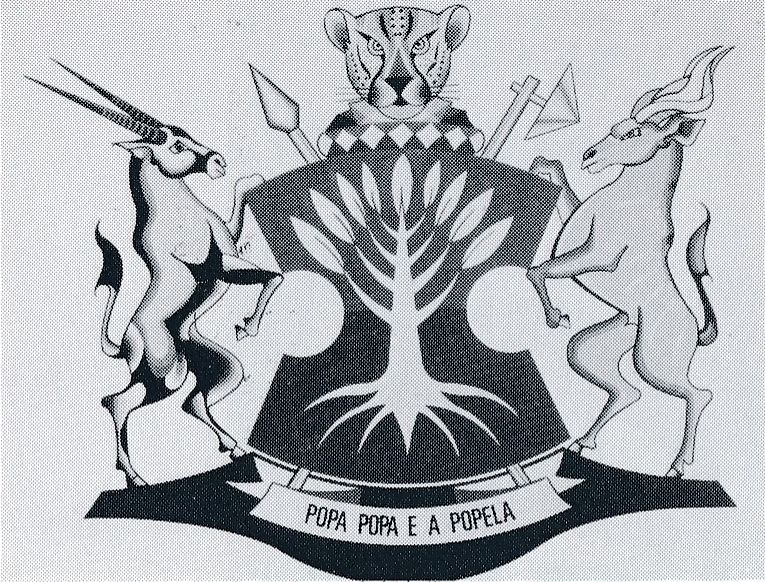Tswanaland: Difference between revisions
Knorrepoes (talk | contribs) m (Text replacement - "{|width="100%" style="color:black; background-color:#ffffcc;" |width="15%"|50 px|left |width="70%" align="center" |'''Heraldry of the World<br/>Civic heraldry of Namibia''' |width="15%"|50 px|right |}" to "{{na}}") |
Knorrepoes (talk | contribs) No edit summary |
||
| Line 6: | Line 6: | ||
===Official blazon=== | ===Official blazon=== | ||
Arms: Per fess Gules and Vert, a tree eradicated Or; behind the | *(af) | ||
Crest: On a head-ring per fess Gules and Vert | '''Wapen''': Deursnede, rooi en groen, 'n uitgerukte goue boom; agter die skild 'n skuinsgekruiste assegaai en Tswana-strydbyl van natuurlike kleur.<br> | ||
Supporters: Dexter a gemsbok and sinister a kudu, both proper.<br | '''Helmteken''': Op 'n hoofring deursnede van rooi en groen en belaai met aanstotende goue ruite, 'n aansiende luiperdkop op 'n rotsgrond, alles van natuurlike kleur.<br> | ||
Motto: POPA POPA E A POPELA | '''Skildhouers''': Regs 'n gemsbok en links 'n koedoe, albei van natuurlike kleur.<br> | ||
'''Wapenspreuk''': POPA POPA E A POPELA | |||
*(en) | |||
'''Arms''': Per fess Gules and Vert, a tree eradicated Or; behind the shiled an assegai and a Tswana battle axe in saltire, both proper.<br> | |||
'''Crest''': On a head-ring per fess Gules and Vert charged with lozenges conjoined Or, a leopard's face on a rocky mount, proper.<br> | |||
'''Supporters''': Dexter a gemsbok and sinister a kudu, both proper. <br> | |||
'''Motto''': POPA POPA E A POPELA | |||
===Origin/meaning=== | ===Origin/meaning=== | ||
The arms were officially granted on 1 September 1988 and were abolished on the independence of Namibia in 1990. | The arms were officially granted on 1 September 1988 and were abolished on the independence of Namibia in 1990. | ||
The arms make use of a stylized Tswana shield bearing a tree, the totem of that branch of the Tswana nation. Ensigning the shield is a headring which supports a leopard's face, the leopard being a symbol of chieftainship. The supporters, an oryx and a kudu, are indigenous to Tswana. They both also featured in the now defunct arms of the Territory of [[South West Africa]]. | |||
{{media}} | {{media}} | ||
Latest revision as of 14:23, 22 February 2020
| Heraldry of the World |
| Namibia heraldry portal Civic heraldry of Namibia |
|
TSWANALAND
Official blazon
- (af)
Wapen: Deursnede, rooi en groen, 'n uitgerukte goue boom; agter die skild 'n skuinsgekruiste assegaai en Tswana-strydbyl van natuurlike kleur.
Helmteken: Op 'n hoofring deursnede van rooi en groen en belaai met aanstotende goue ruite, 'n aansiende luiperdkop op 'n rotsgrond, alles van natuurlike kleur.
Skildhouers: Regs 'n gemsbok en links 'n koedoe, albei van natuurlike kleur.
Wapenspreuk: POPA POPA E A POPELA
- (en)
Arms: Per fess Gules and Vert, a tree eradicated Or; behind the shiled an assegai and a Tswana battle axe in saltire, both proper.
Crest: On a head-ring per fess Gules and Vert charged with lozenges conjoined Or, a leopard's face on a rocky mount, proper.
Supporters: Dexter a gemsbok and sinister a kudu, both proper.
Motto: POPA POPA E A POPELA
Origin/meaning
The arms were officially granted on 1 September 1988 and were abolished on the independence of Namibia in 1990.
The arms make use of a stylized Tswana shield bearing a tree, the totem of that branch of the Tswana nation. Ensigning the shield is a headring which supports a leopard's face, the leopard being a symbol of chieftainship. The supporters, an oryx and a kudu, are indigenous to Tswana. They both also featured in the now defunct arms of the Territory of South West Africa.
Contact and Support
Partners:
Your logo here ?
Contact us
© since 1995, Heraldry of the World, Ralf Hartemink 
Index of the site
Literature : Brownell part V













